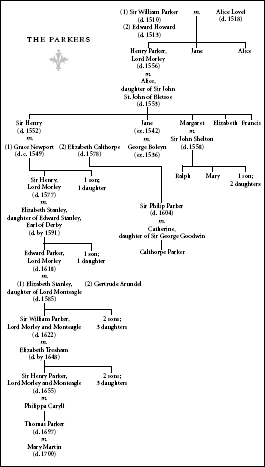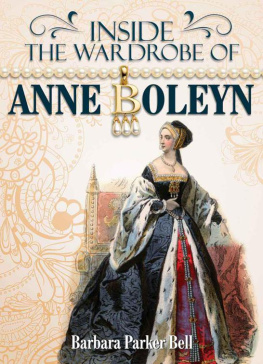

CONTENTS
In Memory of My Parents



NOTE ON UNITS OF CURRENCY
In citing units of currency, the old sterling denominations of pounds, shillings, and pence have been retained. There are twelve pence in a shilling (modern 5p or US$.10), twenty shillings in a pound (1 or US$1.95), and so on. Equivalents for Tudor gold and silver coins are noble (modern 45p or US$.90), angel (33p or US$.66), royal or rose noble (50p or US$1.00), sovereign (100p or US$1.95), and groat (1.6p or US$.03). A mark is thirteen shillings and four pence (66p or US$1.20). One hundred marks is sixty-six pounds (US$130). Estimates of modern values for sixteenth-century figures can be obtained by multiplying all the numbers by one thousand.
PROLOGUE
The Hand of Fate, 1511

T HEIR WAY LIT by the flickering light from great wax torches and to the soothing sound of chanted prayers, the mourners walked solemnly toward the three black-draped barges ready at the rivers edge. Among them were the leading men of the land, entrusted with the somber task of accompanying the tiny coffin containing the body of the infant prince to its resting place with his ancestors in the Abbey Church of St. Peters at Westminster just a few miles away. It was February and bitterly cold. The icy waters of the Thames lapped against the sides of the vessels, the leafless trees stood stark and sentinel as if to guard the baby on whom so many hopes had rested, the breath of the oarsmen was clearly visible as they watched the casket being gently brought aboard. The final journey had begun.
A tolling of the bells could be heard as the cortge made its way slowly from the royal palace of Richmond where the child had died so suddenly to the Abbey where the monks waited patiently. All would be done according to strict protocol and tradition, every minute detail of the prescribed ceremonial observed. Eight royal officers, yeomen and grooms of the household, were stationed at the door of St. Peters to receive the tall funeral torches, thick wax and resin candles fixed into wooden holders, carried by the twenty appointed torchbearers. The choir, which faced the sanctuary, and the catafalque on which the coffin would be placed were draped with over three hundred yards of black cloth, arranged under the meticulous supervision of Ralph Jenet, the yeoman of the Wardrobe of Beds. He could never have performed a more poignant task for the king, his master. The air inside the church was laden with the smell of the burning wax and the soft fragrance of the incense.
Light and color abounded, for all was decorated for the glory of God. The walls were covered with paintings in vibrant reds and blues and greens and yellows or with richly embroidered hangings that glittered with gold and silver thread. Sculptures of stone angels smiled benignly down on the intricately carved friezes of birds, flowers, and foliage adorning the tracery around the monuments or the niches encircling the painted and gilded statues of saints. Diffused light of every shade and hue flowed through the panes of the towering stained-glass windows. The dancing flames of hundreds of candles were everywhere. The shrine, shimmering with gold and precious stones, containing the remains of St. Edward the Confessor, a founder of the Abbey, was encased in its own chapel together with sacred relics such as a thorn from the crown of thorns, the girdle of the Virgin Mary, and a phial protecting a few drops of the blood of Christ. The chapel stood proudly in the heart of the church, just behind the high altar, itself a stunning testament to medieval skill, craftsmanship, and faith. It was the perfect setting for the burial of a prince.
More than four hundred people were present at the interment. One hundred eighty paupers held yet more torches as they walked in the procession. They took their role in the ceremony very seriously because the prayers of the poor would help those facing divine judgment. Five of the kings knights carried specially made funeral banners. Then came the elaborate hearse swathed in over seven yards of black cloth of gold and decorated by painters who had worked day and night to complete it. Four knights reverently bore the coffin, covered with black cloth of gold and with a white cloth of gold cross upon it, over which there was a canopy held by four more knights. Four earls, a marquess, barons, and yet more knights followed. Next came chaplains, preachers, those who were daily waiters upon the prince, even two knights whose job it was to ensure that the correct order of precedence was maintained among the congregation. Nothing was left to chance. The mourning robes themselves were graded in fabric and richness according to the rank of the wearers, the chief of whom wore hoods covering their heads.
The king had chosen the childs final resting place carefully. He was placed as near as possible to those previous kings whose ranks he could join only in death. He would never sit on St. Edwards Chair with the crown on his head; he would lie on the left-hand side of the altar, close to the canopied tomb of Edmund Crouchback, the youngest son of Henry III, a few steps from the Chapel of St. Edward. The customary, consoling words of the Latin burial service began, the coffin was ritually sprinkled with holy water and censed at each of the four sides, and as the echo of the final prayers and the antiphons led by the kings composer and musician, Robert Fayrfax, faded away, everyone left the confines of the church. The monks could once again carry out their daily routines uninterrupted by the formalities of state. And the baby could sleep.
It was all so different from just seven weeks earlier in 1511 when his birth was announced on New Years Day. His parents were King Henry VIII of England and his queen, Katherine of Aragon. He was their first living child. They were still young, the king not yet twenty, although Katherine was almost six years older, and both were delighted that the succession was now assured. The boy seemed healthy; there was every reason to believe that he would be joined by brothers and sisters in due course. Henry was so grateful, he rode to the shrine of Our Lady at Walsingham, Norfolk, to give thanks, a journey of about two hundred miles. Bonfires were lit in the streets of London to celebrate the birth; free wine provided for some lucky revelers; the happy news proclaimed throughout the kingdom and to the royal courts of Europe. The child was christened Henry after his father and grandfather, the first Tudor monarch.
In the second week of February, Henry VIII and Katherine attended two days of magnificent jousts in the childs honor at the palace of Westminster. The queen presided over the tournament serenely, secure in the knowledge that she had fulfilled her primary function as consort by producing a son. On the second day, she presented the prizes to the victors, including one to her husband, for Henry joined the lists as the gallant Loyal Heart. The chief nobles of the land were all there. No one imagined that the little prince would die just ten days later and would lie in a grave not far from the tiltyards.
Next page















